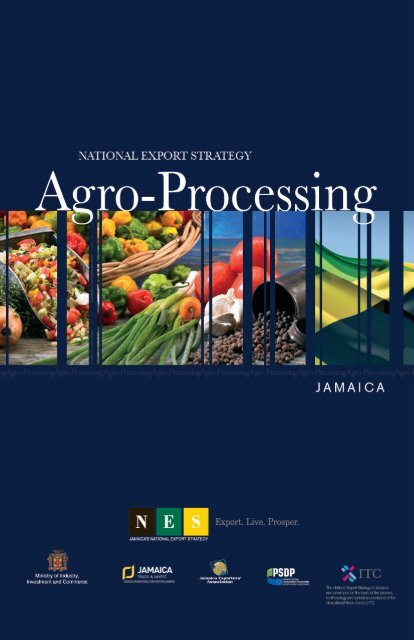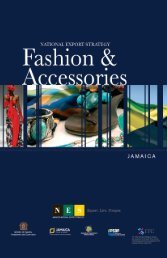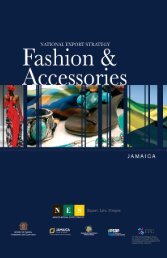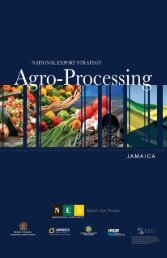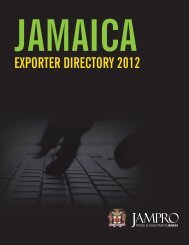Agro Processing Strategy
Agro Processing Strategy
Agro Processing Strategy
Create successful ePaper yourself
Turn your PDF publications into a flip-book with our unique Google optimized e-Paper software.
Jamaica, a leading per capita exportcountry known for its commitment tocreativity, innovation and exceptional quality.The National Export <strong>Strategy</strong> of Jamaicawas developed on the basis of the process,methodology and technical assistance of theInternational Trade Centre (ITC).w w w . j a m a i c a t r a d e a n d i n v e s t . o r g / n e s | 1 - 8 8 8 - 4 2 9 - 5 N E S ( 1 - 8 8 8 - 4 2 9 - 5 6 3 7 )
4i n d u s t r y sec t o r strategy<strong>Agro</strong>-<strong>Processing</strong>IntroductionRationaleThe <strong>Agro</strong>-processing sector is one ofthe most important contributors to thecountry in terms of GDP, and employment.In terms of export performanceand contribution, agro-processedproducts and beverages account forapproximately 6% of Jamaica’s exportsas the third largest export contributor. 1The country’s exports increased by 43%in 2008; proving the sector is a reliableand consistent contributor to exportgrowth. Also, the export profile ofJamaica has been improved based on thecontribution of non-traditional exportsto its diversification, and the growth inthat area.This is supported by the backwardlinkages of the industry from a rangeof agricultural products from acrossdifferent geographic areas where they areproduced. Its linkages extend forwardbeyond agriculture to tourism, packagingand other supporting industries.The strength of specific brands has alsocontributed to the national brandingand has afforded opportunities forbrand leveraging for further increasingexports.Market opportunities continue to growwith growing product demand anddemand for Jamaican brands. Thereare no market threats based on accessassociated with established standards,and compliance. It is therefore forecastto be a continued contributor to exportgrowth and is therefore selected as apriority industry for the export strategy.Unfortunately, the industry also generatesa number of environmental pressureswhich will need to be improved in themedium and long-term, including:• Production of solid and liquid wastesfrom manufacturing processes,• Contribution to solid waste buildup,including non-degradablepackaging materials for which thereare limited recycling facilities, and• Air pollution.The overall national impact is a positiveone, however, and the growth of theindustry is integral to the country’sdevelopment, particularly in light of itspotential for diversification, greater valueaddition and export demand.Product Groups and RelatedProgrammesVision 2030 Jamaica has developed asingle strategy for the Manufacturingand <strong>Agro</strong>-<strong>Processing</strong> sectors, anddefines the agro-processing sub-sectoras the secondary industry processingagricultural raw material into food and1 Calculations are based on the product groups specified in 1.2 .
a g r o - p r o c e s s i n g 5beverages. This general definition ofprocessed foods and beverages is usedfor agro-processing for the NES.The strategy group further specifiedthe product ranges for food productsincluded in the strategy based on thenature of processing that the agriculturalinputs undergo, and are classified toinclude:• Canned goods: soups, vegetables• Sauces• Dry pack foods• Frozen foods (in particular readyto-preparemeals)• Puree• Baked goodsThe product groups comprising thebeverages side of the industry forpurposes of the Export <strong>Strategy</strong> are(i) rum, (ii) beer (iii) non-alcoholicbeverages - both carbonated and noncarbonated.Where Do We Want to Be?The VisionThe Vision Statement for theManufacturing Sector for Vision 2030Jamaica is:“A dynamic, vibrant, marketled manufacturing sectormaking high value added worldclass products desired byconsumers everywhere, usingappropriate technologies andenvironmentally sustainableprocesses, linked to othersectors, with motivated,productive employees, withinan enabling business andregulatory environment”The Jamaica <strong>Agro</strong>-Processers’Association (JAPA) in their strategyarticulated the following as their vision forthe industry in the Jamaican economy:To become the leading 2 nontraditional(goods) exportsector by 2013.For the NES, the latter was modified:“To become the fastest growingnon-traditional export sectorby 2013”The two vision statements arecomplementary, as by achieving the firstthe latter may be realised. However, this2 Leading meaning fastest growing.
6i n d u s t r y sec t o r strategyvision maintains the industry’s focus onexport competitiveness.Strategic ObjectivesThe goal for the sector is to increaseoutput and export value by increasingproduction of current products andwidening the product line by developingnew products. Specific strategicobjectives are:• To increase exports by 15% eachyear by improving access tooverseas buyers;• To introduce 5 new products byyear 2012 to the export market;• 60% of the industry has adoptedfull global best practices in order toachieve improved efficiencies andimprove productivity;• To improve JAPA so that it is avibrant association driving thesector’s development policies andprogrammes.Where Are We Now?An AssessmentExport Performance andAssessment of OverallCompetitiveness<strong>Agro</strong>-processing is a viable componentof the non-traditional export category.Processed foods are the most importantelements of this product group. Thecomprehensive summary below includespoultry meat, sauces and juices.In 2006, processed food exportsincreased by 41.3% to USD71.6; largelyattributable to demand for naturalbeverages in the USA. 3 In addition tojuices, the sauces product group is amajor non-traditional export. In 2006,sauces exports valued US$8.8m. Thisrepresented an 11% increase over theprevious year’s exports.Table 1: Total Exports Processed Foods Sector 2002 – 2006 (USD‘000s)2002 2003 2004 2005 2006 Annual GrowthRate (1)2002-200642,790.8 47,280.9 49,408.2 50,669.8 71,599.7 13.73%3Economic and Statistical Survey of Jamaica 2006 (Planning Institute of Jamaica, 2007).
a g r o - p r o c e s s i n g 7Table 2: Exports of selected agro-processed goods, 2002-2006(Value, USD thousands)Good 2002 2003 2004 2005 2006 2007 2008Other Fruits& FruitPreparationsMeat & MeatPreparations3.8 2.9 2.6 4.1 4.22.1 3.0 2.1 2.1 2.0Sauces 7.8 8.4 7.9 8.8 8.0Source: Exports, 2003-2007 (Statistical Institute of Jamaica, 2008)Beverages are Jamaica’s third mostsignificant exports, after inorganicchemicals and mineral fuel exports. Thisproduct category contributed US$135mto exports, with spirits, liquors and otherspirit beverages topping the productgroup at US$45m. Two products havebeen identified as emerging products –beer (made from malt) and mineral andaerated waters, which saw an increasedshare in world exports of 17 and 52%,respectively. 4Overall, exports of Beverages andTobacco had increased over 14% toUSD90 million.Within Jamaica’s export profile, someof the products are losing market shareto other exporters, while global demandis decreasing. For the sector, carefulpositioning is important to produce theright product for which there is growingdemand, and identifying the best marketsis also important. This means also thatthe competitiveness of the sector needsimprovement.A key factor in competitiveness for thesector is cost. In Jamaica, fixed costsas a percentage of total manufacturingare higher than in the other countries,reducing the ability of Jamaicanenterprises to be cost competitive. Asarticulated in the cross-cutting areaon human capital, Jamaica also haslower rates of productivity in industriessupporting manufacturing includingtransport, construction, and finance,with lower growth rates in productivitywhich have indirectly affected thecompetitiveness of the manufacturingsector.4International Trade Statistics, 2006 (CountryMap/Jamaica) (International Trade Centre, 2008).
8i n d u s t r y sec t o r strategyThe following was excerpted fromthe Vision 2030 Sector Plan forManufacturing:Other studies, for exampleWint and Shirley (1995) whichindicated that the main challengesto the competitiveness of themanufacturing sector includedlow worker productivity, high costof capital, obsolete technology,high operating costs includingutilities, and inadequaciesin supporting infrastructureand bureaucratic systems.More recently Hussey (2002)concluded that the main issuesaffecting labour productivityin Jamaica included a lack ofnational focus on productivity,lack of adequate managementand measurement systems andprocesses, high cost of capital,and education and skill levels ofthe workforce.One of the key issues for thelong-term competitiveness of themanufacturing sector is the needto improve productivity, includingthrough the following measures:• Increased investmentin training of staff andestablishment of appropriateproduction and marketingincentives schemes• Adoption of modernproduction technology andmanagement practices• Retooling and equipmentupgrading• Access to available sources oftechnical assistance• Increased capacity utilisationthrough additional productionshifts• Increased application ofresearch and development tomanufacturing processesIn summary, the sector needs to addressseveral issues of competitiveness in orderto achieve its vision, as well as become achampion export sector globally.The industry’s Value Chain– An Illustration and analysisThe following may be noted about thefood products value chain:• The main component is theprocessor, who is considered asthe driving element of the valuechain. The packaging sector is veryimportant, and so too are the growersas these groups impact the quality ofthe processors’ end product.
Value Chain - <strong>Agro</strong>-<strong>Processing</strong>a g r o - p r o c e s s i n g 9
10i n d u s t r y sec t o r strategyValue Chain - Non-Carbonated BeveragesValue Chain - Carbonated Beverages
a g r o - p r o c e s s i n g 11Value Chain - BeerValue Chain - Branded Rum
12i n d u s t r y sec t o r strategyValue Chain - Bulk Rum• Intermediaries (those who buy andconsolidate from growers and sellto processors) provide the benefitof pooling purchases, but presentsome issues as well such as poorhandling that results in some lossof product that reduces sales for thegrower and input quantity for theprocessor.• Intermediaries introduce a markupin the price that impacts costcompetitiveness. Their valueproposition is only consolidation andnot considered to be proportionalto the mark-up in value along thechain.The primary difference between thecurrent and desired futures states is theprocessing of waste to an economic byproduct.A second, related to improvedefficiencies is the introduction of aprimary processing facility that wouldprovide grading, storage and primaryprocessing, and which could eliminateor minimise the participation ofintermediaries. The future chain reflectsthe focus on value creation and addition,as well as efficiencies.Value Chain AnalysisImproving Eficiencies• The following would improveefficiencies of Growers:o Increased quantity from growersthat would mean increased supplyand reduced bargaining power ofthe growers.
a g r o - p r o c e s s i n g 13o Improved harvesting and postharvestingtechniques forgrowers would reduce wastageand increase revenue for thegrowers as well as supply, andenhance quality of inputs for theprocessors.o Growers also need technicalinformation and training, such asthe best times for reaping.• Grower – Purchaser transaction couldbe improved by the following:o Group purchasing of productsin bulk to reduce per unit costof items as well as shipping andother transactional costs.o Efficiency may be improved bypurchasing directly from growersinstead of intermediaries, whichwould mean better quality(processors), and prices (both).However the following wouldbe required for significantimprovements from this channel:• Increased quantities availablefrom individual farmers bymoving to orchards or relatedsystems and practices.o Arranged purchasing betweenbuyers (processors orintermediary) and grower shouldalso inform reaping time to plan forstorage and transport to maintainthe quality.o Transportation means (vehicles inparticular) impact the products aswell, and require improvements.• The following would improveefficiencies of Processors:o Retooling which is a criticalsuccess factor and therefore apriority.o Technical expertise to properlyadvise processors on retooling.Such as selecting the bestequipment, preparing costbenefitanalyses, arranging sharedpurchase of investment for shared/ contract use.o Financing constraints oftenleads to compromise on capacityor lifetime of equipment forretooling.Reducing Leakages• The following issues and desiredresponses for reducing imports wereidentified:o Raw material (agricultural inputs)
14i n d u s t r y sec t o r strategysourcing may be reduced withinvestment in better seeds forincreased domestic production.The only raw material inputs thatare sourced locally 100% arecallaloo, breadfruit and ackee.All other raw material inputs aresourced internationally as well,and at times with the most beingimported.o The establishment and operationof a primary processing facility thatwould allow for storage of seasonalitems that would be made availablefor longer than the correspondingseason of the crop.o Energy use from imported fuelswould be reduced with theintroduction of alternate andrenewable sources of energy infacilities.Creating Value• The following issues and desiredresponses for reducing imports wereidentified:o Improving the productdevelopment expertise andtechnology to facilitate newproduct development.o Use of processing waste. Examplesinclude compost, energy, bricks,and fertilisers.o The introduction of new productlines based on the possibleprocesses of inputs that exists,such as dried fruits.Adding Value• By focussing on premiumpositioning through appropriatebranding and packaging, firmsmay add value with the existingproduct lines.• Commercial quantities of rawmaterial are needed.• Intellectual property (IP) protectionbecomes critical to this strategyfor the firms, and the country,including the registration andmanagement of geographicindicators (GIs).Performance against CriticalSuccess FactorsThe critical success factors for the sectorare considered to include:1. Manufacturing efficiencies thatensure quality products produced
a g r o - p r o c e s s i n g 15at the most effective costs whileproviding reliable delivery;2. Extent of product development (andinnovation);3. Strong brand (based on product withmarket appeal) that is supported by atalented marketing team; and4. Supply consistency.The industry is not satisfied with thecurrent levels of performance againstthese critical success factors, andbelieves that based on the potential ofits enterprises the underperformance,if addressed could be transformedfor improved export performance.Specifically, the levels of efficienciesare only moderate, while productdevelopment, in terms of the number ofenterprises engaged in innovation is low.The industry believes that performancein the area of brand is strong, but maybe impacted on the area of delivery dueto low rating in supply consistency.Government Policy and <strong>Strategy</strong> inSupport of the SectorThe National Industrial Policy hadidentified agro-processing as one ofthe primary areas of focus towards thedevelopment of the country. As suchit is covered in the mandates of severalagencies for support, with resourcesallocated to the development of thesector. Also, there are a number ofincentives available for manufacturersincluding the following:• Modernisation of Industry (MOI)Programme• Customs User Fee Waiver• Accelerated Depreciation/SpecialCapital Allowance• Export Industry Encouragement Act• Jamaica Export Free Zone Act• Factory Construction LawAs noted, it is included as a priorityindustry for Vision 2030 Jamaica.The Sector’s Trade SupportNetwork: Capacity, Competencyand CoordinationThe Ministry of Industry and Commercehas portfolio responsibility for guidingthe development of the manufacturingand agro-processing industry. The TSNcomprises the Ministry of Agriculture(including RADA, Plant Quarantine,Food Infestation), Scientific ResearchCouncil, Bureau of Standards Jamaica,
16i n d u s t r y sec t o r strategyMinistry of Health, Ministry of Industry,Investment & Commerce, JTI, JEA,JAPA, CABA, JMA, Jamaica Customs,Trade Board. Other service providersinclude the Mona Institute of AppliedSciences, and private labs.General issues include coordination,and some of these are highlighted inthe Quality Management cross-cuttingstrategy. The main area of fragmentationidentified is among the standards entities.Another general concern is the level ofinformation sharing – including crossmeetings.Some specific institutionalissues include:SRCBSJo Focus on commercialisation inorder to earn revenue (ratherthan their core function relatedto industry development andsupport).o They are thought to be competent,having sufficient technicalresources.o Their direction and research couldbe more market-driven.o Some equipment may needupgrading.o There is a focus on commercialJTIrevenues as well by offeringcourses and lab services, whichcould and should be offered by theprivate sector.o Also due to their revenue drive,services are expensive.o They need to increase capacity toincrease staff available to carry outfunctionso The industry finds that themany new persons are not yetwell informed and competent,therefore training may need to beenhanced.o Has an ad-hoc approach tomarket development, rather than astrategic market development andpenetration approach.o The quality of market informationneeds improvement.o Not sufficiently responsive toclients.o Their mandate is not clear to theirclients.o The EC/BIPs• Platform development andpromotion will be critical.• Information officers in the
a g r o - p r o c e s s i n g 17partner agencies will very likelyneed improvement.RADA (indirect TSN member – but criticalto growers)o Has the potential due to its positionto link processors and growersin international requirements.o Poor dissemination of information.o Poor coordination for policy inputs– getting feedback from industryfor policy development.o Poor job carrying out its mandate:there is a need to retain to corefunctionso Strengthen extension servicesand the competency of extensionofficers (these services are felt tobe non-existent).o Poor and inaccurate informationprovided by RADA to the Ministryin order to inform policy, planningand production (e.g. ABIS).Ministry of Agricultureo There is a disconnect betweenthe leadership and its agenciesand divisions reflected in theirnot complying to the directives.Therefore improvement incoordination needed.o There is limited follow up.o Need to strengthen policy for theindustry.Plant Quarantineo Does not appear to be competent
18i n d u s t r y sec t o r strategySWOT Analysis of the SectorThe Jamaica <strong>Agro</strong>-Processors Association (JAPA) recently conducted a SWOTanalysis for the industry, which is provided below. Additional points from the V2030were introduced.Strengths• Brand equity and strong country oforigin reputation.• Unique products.• Export-orientated, diverse productrange. (Strong export orientation)• Support programmes in place for theindustry.• Presence of industry competition todrive performance.• Standard compliance and qualityproducts.• World-class enterprises within thesector.WeaknessesWeak export focus among a manypotential and current exporters.• Exporters are too USA-focussed.• No IP protection in place.• Uncoordinated marketing effortsamong the industry.• Mistrust, poor networking betweenprocessors.• Ability to make high quality products• Established niche markets, brandsand products.• Availability of some ‘green’ rawmaterials.• Water quality.• Established channels to the targetmarkets with experience to expandreach – supply chain is wellestablished.• Reasonable and improving productdevelopment competency exists.• Weak strategic alliances betweeninternal and external entities.• Inadequate linkages in the supplychain.• High Import content.• Insufficient innovation in technologyand product development.
a g r o - p r o c e s s i n g 19• Few companies follow bestpractices and quality standards.• No foresight and planning relatedto new product groups (valuecreation).• Weak coordination among policyand services entities that supportor guide the industry (Ministriesand agencies).• Low uptake of available incentives.• Poor utilisation of funding andtechnical assistance.• Poor supply chain management• Weak procurement networks.• Inconsistency in quality and supplyof domestic raw materials.• Weak knowledge of externalconsumers, technology, andmarketing trends.• Limited innovation to matchevolving market trends.• Inadequate levels of matchingquality, environmental, health andpackaging standards.• Limited availability of skillsnecessary to build viablebusinesses including:° Marketing° Quality Assurance° Production/Factory Management.° Technical/Engineering/Maintenance.° Inadequate plant systems andnew technologies.• Mismatch of market trends/needsand technical applications.• Low utilisation of QualityManagement Systems (QMSs).• Weak linkages to R&D resources(private and academic), e.g.: SRC,SIRI, etc.• Weak product innovation.• Limited use of environmentallyfriendly/clean production technologies.• Limited of use of waste as aresource.• Low utilisation of EnvironmentalManagement Systems (EMSs).• Many companies undercapitalised• Many lack good marketing skillsset (marketing and brand-buildingis weak on average).• Some companies lack theaggressiveness to go after newmarket opportunities.
20i n d u s t r y sec t o r strategyOpportunities• Proximity to main export market(USA).• Strong demand for Jamaicanproducts, which is increasing insome markets.• Research and Developmentsupport is available.• Plant layout and design supportavailable.• Access to product knowledge.• Training programmes areavailable.• Climate and soil quality conduciveto growing certain crops.• Environmental positioning basedon products and processes/systems.• Growth in potential linkageindustries – such as wellness.• Tourism market growth - capacity.Threats• Increasing theft in the industry.• Lack of a clear Agricultural Policy.• Continued increase in labour costswithout corresponding productivityimprovements.• Low growth in the domesticmarket.• Low levels of investment in thesector.• Increasing security costs.• Continued urban migrationreducing the labour force for thesector.• Poor perception of agriculture as aviable economic sector.• Inadequate (poor) transportationimpacting on product qualityarriving to processors.• Weather conditions impact rawmaterial (ingredient) supply.• Increasing numbers of internationaland local environmentalregulations.• Exports of Jamaican “knock-offs”.• Violation of geographic indicatorsby foreign manufactured products.• New product development incompeting countries.• Multiple occurrences of productsarriving without proper labelling,
22i n d u s t r y sec t o r strategyas acceptance of raw material.Many grant funds do notconsider some expenses aseligible costs for funding, likevehicles and land preparationwhich are critical items, andthat are more expensive nonoperational(capital) expenses.• There is no technologicalfocus, and limited expertise toguide retooling for improvingefficiencies.• As with other sectors, accessto capital at a reasonable costlimits capacity development,and product development.• High cost of productdevelopment, particularly forsmaller firms if undertaken bythe firm itself limits levels of newproduct development. Suchwork is undertaken by the SRC,but is expensive to acquire andcommercialise.• Insufficient use of informationtechnology based on limitedawareness on how its applicationdrives efficiency.• Too few skilled scientists/technicians in technicalsupport fields such as productdevelopment and testing.• Poor entrepreneurial skills (andintrapreneurial skills within firms)in the industry (primarily due topersistence of older practicesand few new entrants).• High cost of factory space andlimited availability in preferredlocations.Strategic Consideration # 3– Border Issues and Priorities• High Government bureaucracythat slows the pace of businessand impacts productivity.• Praedial larceny results inreduced supply and increasedproduct ingredient costs.• There is no harmonisation ofimport policy.• Land transport costs increaseswith the absence of rail. Itis noted however that roadtransport allows for promptdelivery response typically within24 hours. Rail transport would beinflexible, based on the specificschedule while the loading andoffloading from rail to road addsanother step and therefore time.Rail would be an option for onlysome road transport.• High port charges that are
24i n d u s t r y sec t o r strategyin some cases have achieved globalexcellence. This sector has some ofthe most experienced exporters in thecountry.Potential Exporters and OtherPotential Participants in the ValueChain:Potential exporters are firms with theproduction capacity and sufficientdomestic market experience andsales that would only require marketentry support. Based on domesticperformance, the transition toexporter may not require significantresources, as the level of productionand capitalisation for success in thelocal market also have to be significantand may already be sufficient for theexport market.Aspiring Exporters and OtherAspiring Participants in the ValueChain:There are new firms producinginnovative products, many of whichare linked to indigenous products.The production level and domesticsales are typically small, and exporttransition may not be very easy.Export markets would be based onniche positioning.Implications for Sector SupportServicesBased on the experience andresources of the exporters in thissector, the trade promotion agency,and technical support agenciesare sometimes not as advanced orexperienced as the firms’ own staff,or less resourced. Adequate supportis therefore a challenge to some ofthe large firms, despite their need forsuch services. While the gaps aretypically highlighted for micro andsmall enterprises, the need to servethe large enterprises that may drivethe industry and national performanceshould not be overlooked.Strategic Consideration #6– Business CompetencySame as cross-cutting industrystrategy.Strategic Consideration #7– Trade InformationSame as cross-cutting industrystrategy.Consideration #8 – FinancingSame as cross-cutting industrystrategy.Strategic Consideration #9– Trade Finance• The high costs of trade finance andgenerally financing an export order for
a g r o - p r o c e s s i n g 25the industry, means that there mustbe emphasis on the general financeissues that have been articulated (incross-cutting strategy) in order toaddress export financing.Strategic Consideration #10– Quality Management• There is poor enforcement ofregulations and standards.• There are inadequate testing facilitiesmaking it difficult to assess productsanalytically.The Institutional PerspectiveStrategic Consideration #11– Strengthening the Sector’s <strong>Strategy</strong>Support Network:In general, the issues are the same asother industries; however the priorityones for the sector are noted:• There is poor agency alignment,as has been highlighted for allindustries.• Many agencies have paperbasedsystems that presentinefficiencies (based on in-personservicing that requires travel fromoffices) and administrative costs.Electronic systems would bepreferred.• Limited to no incubation or startup support for firms.The Jamaica <strong>Agro</strong>-Processors’Association (JAPA) is an affiliateof the JEA. Its purpose is to fosterand drive the industry’s developmentand expansion. At present, onlysome JAPA members benefit fromthe networks and alliances (basedon participation), and despite somestrengths, there are opportunities forstrengthening the entity to drive theindustry’s policy and programmes.JAPA has developed a StrategicPlan for the Association and theindustry. It is recommended thatthis be integrated into the NES andJAPA strengthened to carry out itsmandate, including that of drivingthe implementation of the industrystrategy in the NES.<strong>Strategy</strong> Coordination andManagement:StructureThe proposed structure is thatJAPA, with the JEA, provideleadership and support for thestrategy implementation. Furthersupport will be provided by thesecretariat. It should be notedthat the JAPA consists of primarilyfood processors, however, but
26i n d u s t r y sec t o r strategybeverages companies that aremembers of the JEA may be easilyrecruited and engaged.The beverages sector is very wellrepresented in the major privatesector associations. The emphasison the general areas of export ormanufacturing however may leavegaps in the specific attention thatought to be paid to the issues ofthe industry. There should beconsideration for their joining JAPAor the formation of a sub-sectorspecificworking group. The groupneed not be formally established,but should be given facilitationand administrative support tofoster greater networking, anddiscussion towards partnershipsand clustering to the benefit ofthe industry.Process (<strong>Strategy</strong> Monitoring)JAPA will support the secretariatin the monitoring and reportingfunctions related to strategyimplementation.If the beverages’ working groupor other sub-group is establishedunder the JAPA/JEA, the processrecommended is for this entityto either integrate or becomestrongly aligned.
s t r a t e g y at a glancea g r o - p r o c e s s i n g 27VisionA dynamic non-traditional export industry characterised by high levels ofdiversification, and sustained growth in new and value-added products.Development PerspectiveThe Sector contributes to the development of rural communities through employment, backwardlinkages and a commitment to research and development, and sustainable environmentalpractices.SUPPLY SIDE (BORDER-IN)Flexible financing for theagriculture industry isprovided.Effective re-tooling resultingfrom improved expertise.Product developmentpartnerships result in newproducts successfullycommercialised.More technical skillsavailable in the industry.TRADE INFORMATIONFlexible tradefinance programmedeveloped.Competitiveness PerspectiveTRANSACTION COST OF BUSINESS(BORDER)Praedial larceny issignificantly reduced.Lower, standard port chargesare introduced.STANDARDS ANDQUALITY MANAGEMENTThere is improvedenforcement ofregulations andstandards.There are adequatetesting facilitiesmaking it difficultto assess productsanalytically.Client PerspectiveInstitutional PerspectiveBUSINESSDEVELOPMENT ANDEXPORT READINESSThe technicalexpertise forproduction of qualityproducts is at globalstandards.Marketingmanagement as wellas business proposaldevelopment isimproved.DEMAND SIDE (BORDER-OUT)There is increasedindustry participation inpolicy development andnegotiations. Supportprovided to cover highpromotions costs.Competing illegal exportsdeclines.FINANCEAffordable andaccessible financemade available.PACKAGINGAffordable qualityexport packagingmade availablelocally.The Mines & Geology Division is strengthened to deliver optimal support to industry development,and coordination of services provided by relevant technical entities.
a g r o - p r o c e s s i n g 29a c t i o n planowner/supportobjectives measures targets initiatives entities timelineBORDERCost of DoingBusiness• Foster group purchasing mechanism andinitiatives to facilitate group purchase ofproducts in bulk to reduce per unit cost of itemsas well as shipping and other transactionalcosts.• Facilitate processor-grower buyer matching forpurchasing directly instead of intermediaries,which would mean better quality, and prices.• Facilitate the introduction of alternate andrenewable sources of energy in facilities toreduce use of energy from imported fuels.• Continue lobby for strengthening of initiativesaimed at reducing Praedial Larceny.BORDER-OUT: ALL CROSS-CUTTING INDUSTRY INITIATIVES ARE RELEVANTTHE CLIENT PERSEPCTIVE: ALL CROSS-CUTTING INDUSTRY INITIATIVES ARE RELEVANTQualityManagementTradePromotionPercentindustrycompliant toHAACP, ISO9000 (or ISO200) and14000THE INSTITUTIONAL PERSEPCTIVETo improveJAPA so thatit is a vibrantassociationdriving thesector’sdevelopmentpolicies andprogramme50% • Improve enforcement of regulations andstandards.• Increase the number of testing facilities to allowfirms to assess products analytically.• Design and execute in-bound missions tobring overseas buyers to Jamaica for industryfamiliarisation tours and match-making by.• Design and deliver technical assistancetraining to farmers aimed at improving yield,enhancing efficiencies, crop planning, such aswhen to reap.• Provide technical support and information tosupport training provided.• Develop industry purchasing planning platformto facilitate arranged purchasing betweenbuyers (processors or intermediary) and growerthat provides buyer times that allow growers toplan reaping to correspond with storage andtransport to maintain the quality.• Engage the TSN in discussions on the industrydevelopment programme, their role andfunctions and cooperation towards the agreedobjectives.• JAPA• RADA• Ministryof Agriculture• JAPA• RADAresourcesAll ACPCommoditiesprogramme• JAPA• Provide support for strengthening JAPA. • JEA
w w w . j a m a i c a t r a d e a n d i n v e s t . o r g / n e s | 1 - 8 8 8 - 4 2 9 - 5 N E S ( 1 - 8 8 8 - 4 2 9 - 5 6 3 7 )


